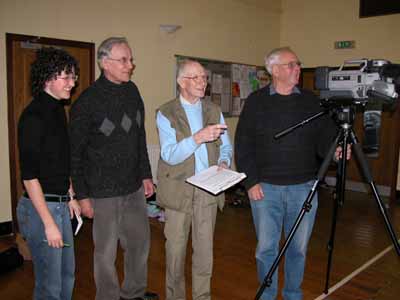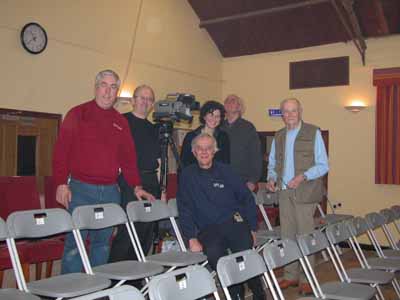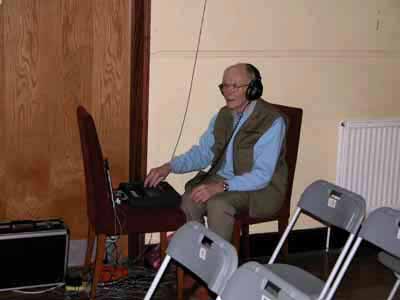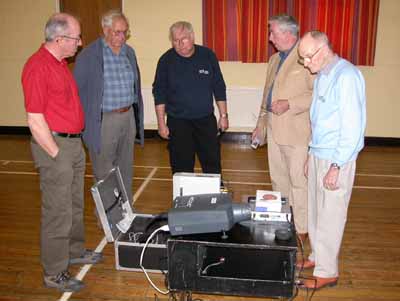 
January 13th 2005 and great excitement
abounds in the village of Hurst. Residents gather as the location caterers
and equipment trucks of RFVM roll into the car park of the village hall…
Sorry! Forgive me, I really must stop my imagination going into overdrive
like Geoff Addis at a video exhibition with an open chequebook!
Let's go back to the beginning…
It all began back in the previous September with an announcement from
Neil to the effect that the club had been approached to see if we would
be interested in filming the Hurst village panto "Snow White".
The consensus was that this could be an ideal opportunity, not only
for members to gain some "professional" experience, but also
to foster good community relations - and have some fun!
Several people expressed interest and so Neil, as project leader, brought
us face to face with the panto representatives on November 18th in order
to sort out roles and responsibilities, and to understand the problems
we could come across.The team roles were decided as:
- Neil Hodgson. Project Co-ordinator/Editing and Post Production
- Don Currie Floor Manager/Audio
- Pete Marsh Camera
- Tony Colvile Camera
- Harry Newland Camera
- Kate Dooley Assistant Editor/Post Prod
The Plan The agreed plan of campaign was to site a fixed cam at the back of
the hall (Harry), the other two cams dolly-mounted either side of the
hall covering the stage (Pete and Tony).
It was decided to use identical cameras and we were fortunate in having
access to the Sony VX9000s lent to us by Brian Hibbitt, Neil and Phil
Bryant. The advantages being that these use 3 hour DVCAM tapes (no fiddling
with tape changing during the performance), each cam could be adjusted
to identical settings (colour balance, 16:9 widescreen,etc), and, importantly,
these cams really look the business. For the cameramen it meant some
considerable time in advance of the show getting used to the kit, and
making sense of the inch-thick instruction book!
Don decided on a four mic set-up: one Sennheiser MKE300 facing each
side of the stage, an AKG cardiod at the front and another to pick up
the keyboard musical accompaniment. All four outputs fed into a Sony
MX-510 five channel mixer with the output taken to the master cam at
the back of the hall.
On a recce visit to the hall, Don and Harry measured up cable runs
and decided on cam positions based upon the seating plan supplied to
us.
It was soon apparent that our initial idea to use the dress rehearsal
(with no audience of course) for the shoot would not work, as it became
obvious that the essence of panto relies on a continuous interaction
with the audience. Neil thought we could capitalise on this by having
Kate and himself capturing ad hoc reactions with hand-held cams during
the performance.
The dress rehearsal, however, became an opportunity for the team to
familiarise themselves with the action. Good idea - it looked like there
could be some problems…
The actual seats were now in position and not quite as the plan we
had been given. There would now be less room than expected, not only
for the cameras but also siting of the mics. During the performance,
hoards of little fairies and elves were accessing the stage via the
two side gangways thus restricting one camera to a very shallow angle
of coverage. In addition, the main mic had to be repositioned in the
centre front row of stalls - not ideal.
The master cam at the back of the hall had to be located on a raised
platform which was prone to shaking at the slightest movement! Not a
lot could be done about it, except to keep Harry firmly strapped down
throughout the performance!
The Shoot
So, with tension building, we all took up our positions as the audience
filed in on the first night, January 13th 2005. Don crouched low over
the mixer, cans clamped to his ears. The three cameramen poised, fingers
hovering over the record button, eyes welded to viewfinders. Cue music!
Cue tabs! We're off!
Don had provided the three operators with intercoms in order that we
could communicate if any particular problem developed. Unfortunately,
these needed to be physically switched for 2-way use which proved impractical
especially for Pete and Tony trying to frame shots, maintain focus and
pull zooms, usually at the same time.
Also the capacity audience was very enthusiastic and responsive in their
reactions (He's behind you! Oh no he isn't!) not only blotting out any
sound in our earpieces, but tending to swamp Don's audio output.In the event we suffered loss of sound to the master cam for about
30 secs during the first act, and a total loss of the right-hand channel
until the interval.

During the second half, I suddenly realised my tally light was off -
I had not been recording for about three minutes!
Fortunately, these were all problems that could be rectified or concealed
in post-production.In fact, everything else went well up to the final curtain. The cast
certainly deserved the fervent applause they received, and the RFVM
team could finally relax.
The Edit
Over the following few days, Neil and Kate got stuck into the editing
using Premiere 6.5 with the Canopus RT2 card. A non-commercial DVD will
only hold a maximum two hours content therefore Neil decided to produce
a double DVD package for Hurst ie: each half of the show per DVD.
There was a huge amount of material to be captured on to the system,
approx 1.5hrs from each of the 3 cams. In addition there was the backstage
material from the roving cams.
The master tape from Harry's camera formed the core of the project
and this was laid on the timeline with the other two tapes on adjacent
tracks and synchronised.
It was then a "simple" case of examining the footage, retaining
useable material and discarding the rest. The best shots were integrated
into the timeline to suit the story and character positions.
It was a shame that much of the ad hoc audience reaction footage was
not useable due to the low lighting, however the finished product looks
extremely professional and the whole team should be justly proud.
The Presentation
We all met again on March 19 at the village hall where the cast members
and friends were to be shown the result of our labours. Phil Bryant
was co-opted and we all joined in to set up the screen and projection
equipment.
A lively audience certainly enjoyed the show, entering into the spirit
just as they did previously.
Profuse thanks were offered to the team at the end (along with some
drinks and nibbles!) and the stack of tapes and DVDs seemed to be selling
well.

Conclusion
We all gained some useful experience of a live event and learned some
valuable lessons for next time, eg:
- It is essential for a clear and detailed brief to be established
and understood by all parties at the outset.
- Harry, on the master cam, had the advantage of a discrete monitor
used as his 'viewfinder' attached to his tripod. These would have
been invaluable for the other 2 cameramen, if only to alleviate aching
backs and awkward posture!
- Balanced mic feeds are advisable to obviate any audio noise.
Most of all, it was great fun! Let's do it again some time!
|



